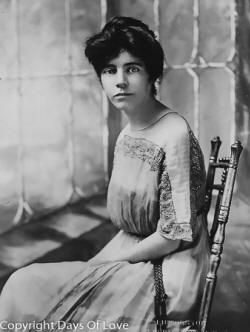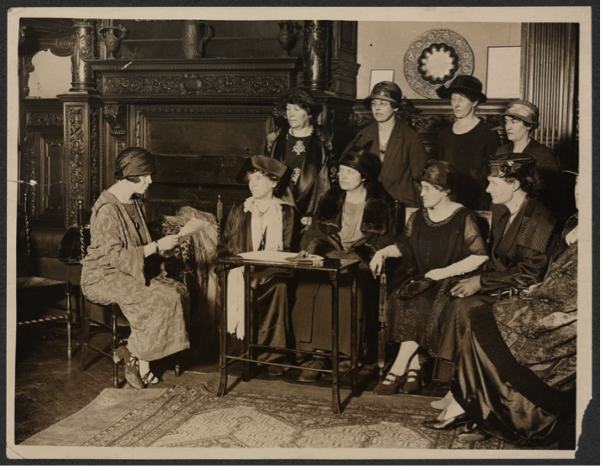

Queer Places:
Paulsdale, 128 Hooton Rd, Mt Laurel, NJ 08054, Stati Uniti
Moorestown Friends School, 110 E Main St, Moorestown, NJ 08057, Stati Uniti
Swarthmore College, 500 College Ave, Swarthmore, PA 19081, Stati Uniti
University of Pennsylvania (Ivy League), 3355 Woodland Walk, Philadelphia, PA 19104
American University, 4801 Massachusetts Ave NW, Washington, DC 20016, Stati Uniti
Woodbrooke Quaker Study Centre, 1046 Bristol Rd, Birmingham B29 6LJ, Regno Unito
Westfield Friends Burial Ground, 2201 Riverton Rd, Cinnaminson, NJ 08077, Stati Uniti
 Alice
Stokes Paul (January 11, 1885 – July 9, 1977) was an American suffragist,
feminist, and women's rights activist, and one of the main leaders and
strategists of the campaign for the Nineteenth Amendment to the U.S.
Constitution, which prohibits sex discrimination in the right to vote. Paul
initiated, and along with Lucy Burns and others, strategized events such as
the Woman Suffrage Procession and the Silent Sentinels, which were part of the
successful campaign that resulted in the amendment's passage in 1920.[1]
Historical figures suspected of having same-sex desires whose personal
documents were destroyed include suffragist
Alice Paul, educator M.
Carey Thomas, interior designer
Henry Davis Sleeper,
and reformers Jane Addams,
Molly Dewson, and
Miriam Van Waters.
Alice
Stokes Paul (January 11, 1885 – July 9, 1977) was an American suffragist,
feminist, and women's rights activist, and one of the main leaders and
strategists of the campaign for the Nineteenth Amendment to the U.S.
Constitution, which prohibits sex discrimination in the right to vote. Paul
initiated, and along with Lucy Burns and others, strategized events such as
the Woman Suffrage Procession and the Silent Sentinels, which were part of the
successful campaign that resulted in the amendment's passage in 1920.[1]
Historical figures suspected of having same-sex desires whose personal
documents were destroyed include suffragist
Alice Paul, educator M.
Carey Thomas, interior designer
Henry Davis Sleeper,
and reformers Jane Addams,
Molly Dewson, and
Miriam Van Waters.
After 1920, Paul spent a half century as leader of the National Woman's Party, which fought for the Equal Rights Amendment, written by Paul and Crystal Eastman, to secure constitutional equality for women. She won a large degree of success with the inclusion of women as a group protected against discrimination by the Civil Rights Act of 1964.
Alice Paul had an active social life until she moved to Washington in late 1912. She enjoyed close relationships with women and befriended, sometimes dated, men. Paul did not preserve private correspondence for the most part, so few details are available. Once Paul devoted herself to winning the vote for women, she placed the suffrage effort first in her life. Nevertheless, Elsie Hill and Dora Kelly Lewis, two women she met early in her work for NAWSA, remained close to her all their lives. She knew William Parker, a scholar she met at the University of Pennsylvania, for several years; he may have tendered a marriage proposal in 1917. The more thorough discussion of Paul's familial relations and friendships is found in J.D. Zahniser's biography.[21]
After her retirement from nursing, Lavinia Dock's activities included membership in the National Woman's Party, led by Alice Paul. Dock campaigned for woman suffrage by leading several protests, including pickets at the White House; she was arrested after militant demonstrations in June 1917, August 1917 and August 1918.[4] She participated in protest movements for women's rights that resulted in the 1920 passage of the 19th Amendment to the U.S. Constitution, which granted women the right to vote.[6] In addition, she campaigned for legislation to allow nurses rather than physicians to control their profession.

Seated at the far left is Alice Paul conferring. Left to Right – Seated – Alice Paul, Elizabeth Robins, Viscountess Rhondda, Dr. Louisa Martindale, Mrs. Virginia Crawford, Dorothy Evans – Standing – Mrs. Pethick-Lawrence, Alison Neilans, Florence Underwood, Miss Barry.
Paulsdale, 128 Hooton Rd, Mt Laurel, NJ 08054
In World War I, Mary Church Terrell was involved with the War Camp Community Service, which supported recreation for servicemen. Later it aided in issues related to the demobilization of Negro servicemen. As the war was winding down, Terrell and her daughter Phyllis joined Alice Paul and Lucy Burns, of the Congressional Union for Woman Suffrage (CUWS), to picket the White House on issues related to the need of black veterans for jobs. Terrell was a delegate to the International Peace Conference after the end of the war.
Paul died at the age of 92 on July 9, 1977, at the Greenleaf Extension Home, a Quaker facility in Moorestown, New Jersey, less than a mile from her birthplace and childhood home at Paulsdale[5] and is buried at Westfield Friends Burial Ground, Cinnaminson, New Jersey, U.S.[22]
Paul and Carrie Chapman Catt both devoted their lives to the women's suffrage movement. They simply had differing opinions on the tactics of raising public and political awareness. Catt believed that the correct method to get womens rights to vote was by a state by state tactic. Paul is also connected with Mary Adelaide Nutting and Isabel Hampton Robb.
My published books: